flask+sqlite3+echarts2+ajax数据可视化
Posted Stay Hungry, Stay Foolish
tags:
篇首语:本文由小常识网(cha138.com)小编为大家整理,主要介绍了flask+sqlite3+echarts2+ajax数据可视化相关的知识,希望对你有一定的参考价值。
前提:
准备Python + Flask+Sqlite3的平台环境(windows系统)
前面一节介绍flask怎么安装了,剩下sqlite3下载后解压,然后环境变量添加解压路径就行了
附加下载地址:http://www.sqlite.org/2016/sqlite-tools-win32-x86-3150200.zip
项目的目录结构
/www
|
|-- /static
| |jquery-1.6.2.js (可以是其他jquery-xx.js,在index.html里修改就行了)
| |-- echarts.js(还有echarts原dist目录下的文件(夹))
|
|-- /templates
| |
| |-- index.html
|
|-- app.py
|
|-- create_db.py
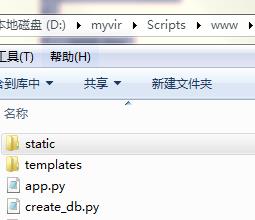
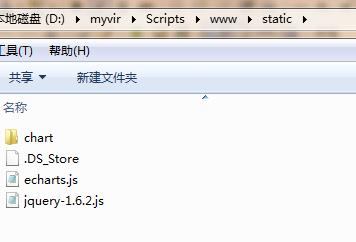

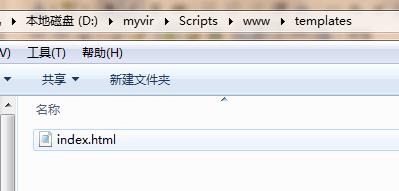
记得下载:echarts,echarts包含:
# create_db.py # 只运行一次!!! import sqlite3 # 连接 conn = sqlite3.connect(\'mydb.db\') c = conn.cursor() # 创建表 c.execute(\'\'\'DROP TABLE IF EXISTS weather\'\'\') c.execute(\'\'\'CREATE TABLE weather (month text, evaporation text, precipitation text)\'\'\') # 数据 # 格式:月份,蒸发量,降水量 purchases = [(1, 2, 2.6), (2, 4.9, 5.9), (3, 7, 9), (4, 23.2, 26.4), (5, 25.6, 28.7), (6, 76.7, 70.7), (7, 135.6, 175.6), (8, 162.2, 182.2), (9, 32.6, 48.7), (10, 20, 18.8), (11, 6.4, 6), (12, 3.3, 2.3) ] # 插入数据 c.executemany(\'INSERT INTO weather VALUES (?,?,?)\', purchases) # 提交!!! conn.commit() # 查询方式一 for row in c.execute(\'SELECT * FROM weather\'): print(row) # 查询方式二 c.execute(\'SELECT * FROM weather\') print(c.fetchall()) # 查询方式二_2 res = c.execute(\'SELECT * FROM weather\') print(res.fetchall()) # 关闭 conn.close()
建立数据库结果:
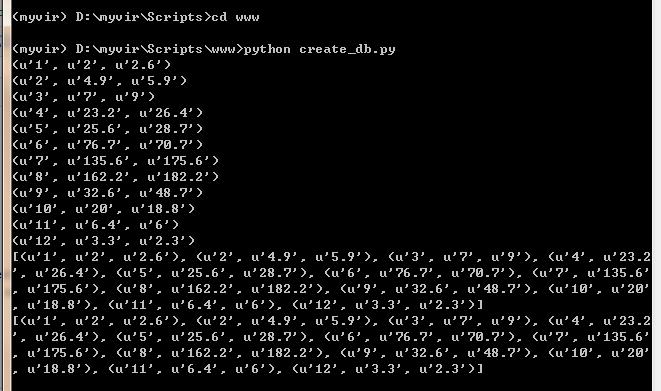
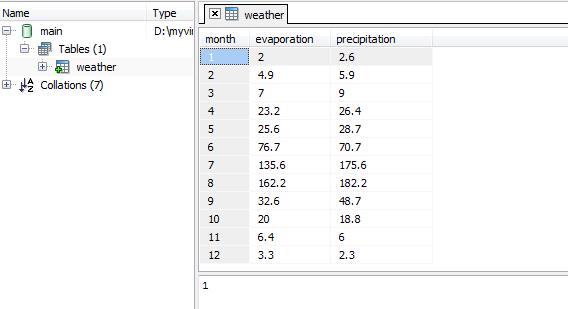
// index.html <!DOCTYPE html> <html lang="en"> <head> <meta charset="utf-8"> <title>ECharts Ajax</title> <script src="{{ url_for(\'static\', filename=\'jquery-1.6.2.js\') }}"></script> </head> <body> <!--Step:1 为ECharts准备一个具备大小(宽高)的Dom--> <div id="main" style="height:500px;border:1px solid #ccc;padding:10px;"></div> <!--Step:2 引入echarts.js--> <!--<script src="js/echarts.js"></script>--> <script src="{{ url_for(\'static\', filename=\'echarts.js\') }}"></script> <script type="text/javascript"> // Step:3 为模块加载器配置echarts的路径,从当前页面链接到echarts.js,定义所需图表路径 require.config({ paths: { echarts: \'./static\', } }); // Step:4 动态加载echarts然后在回调函数中开始使用,注意保持按需加载结构定义图表路径 require( [ \'echarts\', \'echarts/chart/bar\', // 按需加载 \'echarts/chart/line\', ], function (ec) { //--- 折柱 --- var myChart = ec.init(document.getElementById(\'main\')); // 设置--------------------- var option = { tooltip : { trigger: \'axis\' }, legend: { data:[\'蒸发量\',\'降水量\'] }, toolbox: { show : true, feature : { mark : {show: true}, dataView : {show: true, readOnly: false}, magicType : {show: true, type: [\'line\', \'bar\']}, restore : {show: true}, saveAsImage : {show: true} } }, calculable : true, xAxis : [ { type : \'category\', data : [] } ], yAxis : [ { type : \'value\', splitArea : {show : true} } ], series : [ { name:\'蒸发量\', type:\'bar\', data:[] }, { name:\'降水量\', type:\'line\', data:[] } ] }; $.ajax({ cache: false, type: "POST", url: "/weather", //把表单数据发送到/weather data: null, // 发送的数据 dataType : "json", //返回数据形式为json async: false, error: function(request) { alert("发送请求失败!"); }, success: function(result) { //console.log(result); for (i = 0, max = result.month.length; i < max; i++) { //注意:result.month.length option.xAxis[0].data.push(result.month[i]); option.series[0].data.push(parseFloat(result.evaporation[i])); option.series[1].data.push(parseFloat(result.precipitation[i])); }; // 为echarts对象加载数据-------------- myChart.setOption(option); } }); // 为echarts对象加载数据-------------- //myChart.setOption(option); } ); </script> </body> </html>
# app.py import sqlite3 from flask import Flask, request, render_template, jsonify app = Flask(__name__) def get_db(): db = sqlite3.connect(\'mydb.db\') db.row_factory = sqlite3.Row return db def query_db(query, args=(), one=False): db = get_db() cur = db.execute(query, args) db.commit() rv = cur.fetchall() db.close() return (rv[0] if rv else None) if one else rv @app.route("/", methods=["GET"]) def index(): return render_template("index.html") @app.route("/weather", methods=["POST"]) def weather(): if request.method == "POST": res = query_db("SELECT * FROM weather") return jsonify(month = [x[0] for x in res], evaporation = [x[1] for x in res], precipitation = [x[2] for x in res]) if __name__ == "__main__": app.run(debug=True)
运行后:

打开:http://127.0.0.1:5000/

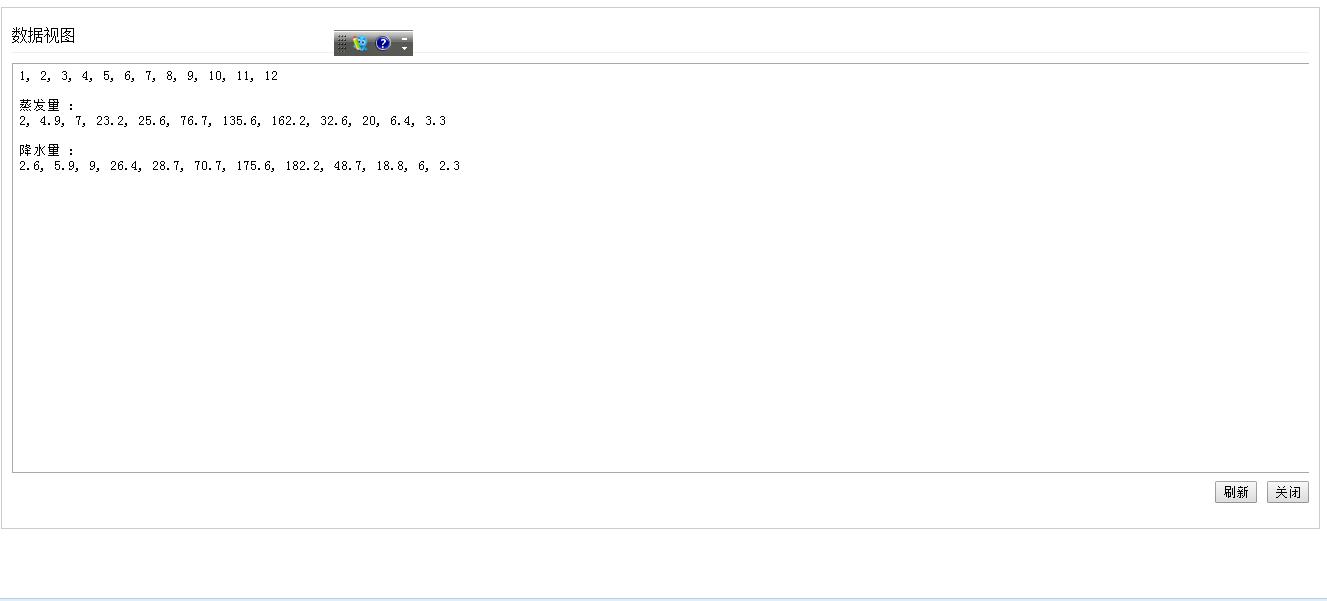


以上是关于flask+sqlite3+echarts2+ajax数据可视化的主要内容,如果未能解决你的问题,请参考以下文章